South Wing Office

The office of the Secretary was located in a room overlooking the south portico for 22 years, from 1875-1897, yet the history of the space is one of the most complex of all the office locations in the Treasury building. Unlike other moves, there is no documented reason for why the office was moved by Secretary Benjamin Bristow. The office underwent two interior design periods, in 1875 and 1884, where design firm Pottier & Stymus changed decoration as well as added bathrooms, telephone lines, radiators and improvements in cooling and air circulation. During the renovation and restoration of the interior of Treasury building in 2000-2007, investigations were made that uncovered decorative painting on the ceiling and much of the design from the Pottier & Stymus scheme. The ceiling exposure remains to highlight it as a future restoration project at the Treasury building.
Civil War Years: The Chase Suite
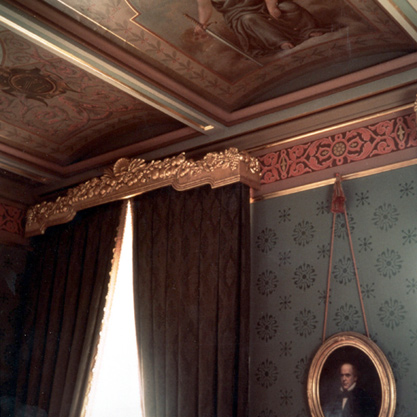
Before the Civil War, the Secretary’s Office was moved to the southeast corner of the building in what is now the Salmon Chase Suite. The suite was completed in 1860, but Salmon Chase was not able to occupy the office until October of 1861 and remained there for three years. Chase was the only Secretary to occupy the office during the course of the Civil War. Before the end of the war, the Secretary’s Office was moved over to the west wing in what is now the Johnson Suite. Thirty three years later, in 1897, Secretary Lyman Gage returned to the Salmon Chase Suite in the southeast corner, where it would remain occupied by the Secretary until 1910. A total of five Secretaries occupied what is now called the historic Salmon Chase Suite.
Earliest Office of the Secretary in the Current Building
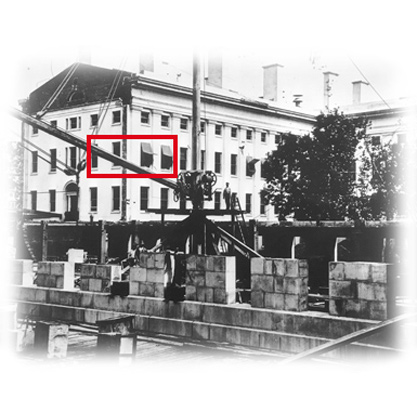
The Treasury Department was located in a series of rented spaces in Washington, D.C. from 1833-1838. The first wings of the new Treasury building (east and center) were completed in 1838. Amongst its 150 offices was the Secretary’s on at the west end of the center corridor, facing the White House from across the west lawn. Former Secretary of the Navy Levi Woodbury was the first Treasury Secretary to occupy this location in 1838. Thirteen Treasury Secretaries occupied that space from 1838 to 1861.
Epilogue

There have been 79 Secretaries of the Treasury in our nation’s history and, over the course of their service; the location of the Office of the Secretary has fluctuated. From the time of Secretary Alexander Hamilton to today’s Secretary Scott Bessent, the Office of the Secretary has been altered due to fires, construction, renovations and innovations. Although the locations of the offices have changed, each space maintains and respects the historic tradition of the Treasury Department.
The First Treasury Building
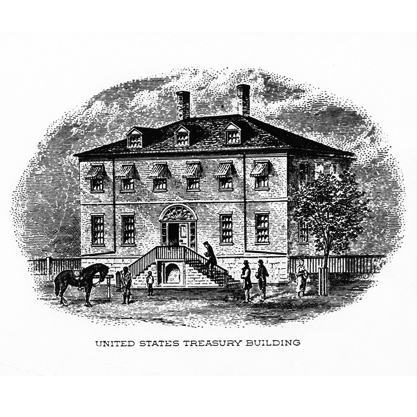
Alexander Hamilton, the first Secretary of the Treasury, was appointed by President George Washington in September of 1795. During the construction of a new nation, Washington and Hamilton worked in New York City and Philadelphia but Hamilton never actually worked in Washington, D.C. The building that awaited the Treasury Department in Washington was a modest 2-story brick Georgian style designed by architect George Hadfield. Filled to capacity, the facility held 69 of the total 131 federal workforce that relocated to Washington, D.C. Nine Secretaries occupied the first Treasury building until the building was lost after suffering multiple fires, causing the Treasury to rent space in temporary venues until a new Treasury building was constructed.
Improvements to the Secretary’s Office

The Secretary’s office had moved back and forth along the south wing since 1861. For a relatively short period of time, from 1875-1897, the office was housed in the third floor pier office flanking the southeast side of the south portico entrance to the Treasury building. Improvements to the office and the adjacent Assistant Secretary’s office continued to be made over the years and in 1886 white oak parquet flooring was installed in the office. A total of twelve Treasury Secretaries occupied this office.
Introduction: Offices of the Secretary Exhibition
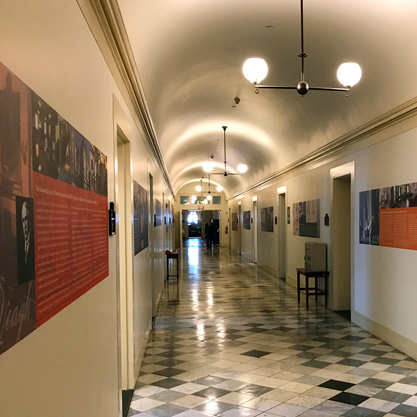
The Offices of the Secretary have spread across 5 locations of the Treasury building, encompassing almost 180 years of American financial history. These historic spaces have been the sites of monumental moments in American history such as the management of the nation’s finances throughout the Civil War (1861-1865), the establishment of our “greenback” paper currency, serving as a temporary President of the United States’ office, and much more. The history of the current office spans WWI, the Great Depression, WWII, the growth of international financial policy and the pioneering use of computing data for fiscal management and analysis.
Post-Civil War: The Andrew Johnson Suite
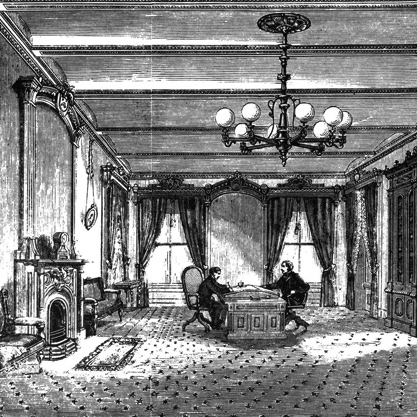
Post-Civil War: The Andrew Johnson Suite In 1864, Salmon P. Chase once again delayed his transition into the west wing office by two months for remodeling. This office remained the office of the Secretary for eleven years, as well as a temporary President’s office. Secretary William P. Fessenden offered President Andrew Johnson use of the office after the assassination of President Lincoln, allowing Mary Todd Lincoln time to grieve and move out of the White House. In the office, President Johnson entertained hours of appointments each day. Despite long visitations, Johnson preferred to stand when meeting with his appointments. Overall, a total of six Secretaries worked in this office. Redesigning the Secretary’s Office The Office of the Secretary was decorated by professional interior designers in the 19th century and again in the early 20th century. In 1864, the New York firm of Pottier and Stymus furnished and decorated the Secretary’s new office in the west wing. One period account referred to the finished space as “elaborately ornamented and elegantly furnished rooms.” In 1909, the firm of Francis Bacon decorated and furnished the Secretary’s Office when it was moved to its present location and where it remains to this day. Bacon worked closely with Treasury’s architects, his decorations complementing their Colonial Revival style ceiling and decorative trim. One of Treasury’s most iconic designs is his Alexander Hamilton portrait in the Secretary’s Office. Today, the Secretary’s office reflects the taste of its immediate occupant, along with the inherited furniture and decorations of their predecessors that have served to create a Treasury tradition.
Redesigning the Secretary’s Office
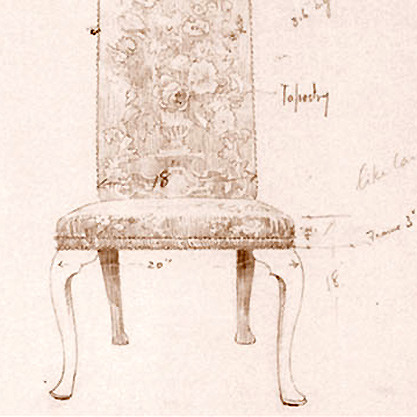
The Office of the Secretary was decorated by professional interior designers in the 19th century and again in the early 20th century. In 1864, the New York firm of Pottier and Stymus furnished and decorated the Secretary’s new office in the west wing. One period account referred to the finished space as “elaborately ornamented and elegantly furnished rooms.” In 1909, the firm of Francis Bacon decorated and furnished the Secretary’s Office when it was moved to its present location and where it remains to this day. Bacon worked closely with Treasury’s architects, his decorations complementing their Colonial Revival style ceiling and decorative trim. One of Treasury’s most iconic designs is his Alexander Hamilton portrait in the Secretary’s Office. Today, the Secretary’s office reflects the taste of its immediate occupant, along with the inherited furniture and decorations of their predecessors that have served to create a Treasury tradition.
Secretary Franklin MacVeagh Residence
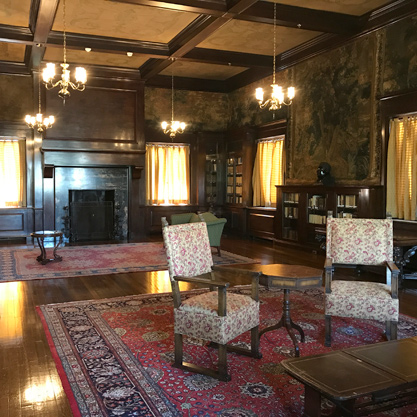
Franklin MacVeagh (1837-1934) was a bank president in Chicago for 29 years before being appointed Treasury Secretary (1909-1913) by President Taft. Both MacVeagh and his wife, Emily Eames McVeagh, were very conversant in design, architecture and construction. While he was working on the Treasury building, she was supervising the construction of their new home on Meridian Hill (2829 16th Street). That house, named to the National Register of Historic Places in 2012, now serves as the Mexican Culture Institute and still retains its original architectural splendor with many of the exquisite details from the time the MacVeagh’s lived in the house.
Secretary MacVeagh Transforms Treasury
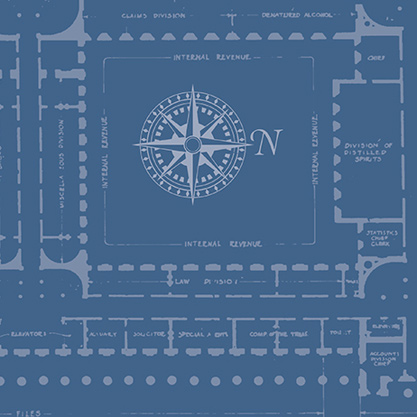
Over the years, the Office of the Secretary has evolved with new security, communications technology and modern conveniences which later on spread throughout the building. In addition to these innovations, the Treasury underwent a series of reassigning of spaces under the direction of Secretary Franklin MacVeagh. The Secretary’s Office was moved to the west wing where the building utilized an existing roadway and door opening to create a private entrance for the Secretary. The overall layout of the Secretary’s suite remains pretty much the same as it was when completed in 1911. Through 2017, the west wing location of the office has been host to 33 Secretaries of the Treasury.
Today’s Modern Office of the Secretary

Since the first Treasury was erected on the present site in 1800, the landmark building has housed the Office of the Secretary. This office has evolved over time and place, reflecting both the expansion of the Treasury building as well as the increasing importance of this cabinet level position. With the current building’s completion in 1869, the Office of the Secretary has occupied spaces in all but the North Wing. As each new Secretary enters Treasury for the first time and sits in their office, they add their own chapter to the legacy of the Department.
